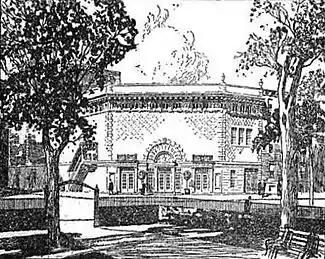


Herman Lee Meader (December 21, 1874, New Orleans [3] – February 14, 1930) was an American architect and author.[4]
Life and career
Meader was born in New Orleans, the son of Herman Frederick Louis Meader and Susanne Lee Meader (née Equen). Meader was educated at Soule Business College[5] and Tulane, Cornell and Harvard Universities,[3] and received a Bachelor of Science from Harvard in 1898.[3] He worked as an architect in New York, first in the office of Ernest Flagg until 1905, and then Raymond Almirall afterwards for about four years.[3][5] Both Flagg and Almirall were known for terra cotta and color effects in their architecture.[6]
Meader married Queenie Ethel Carr in New York on March 17, 1909.[5] After travelling abroad, he returned to New York in 1913 to start his own practice,[5] receiving commissions to design several prominent buildings in Manhattan, both commercial and residential. He also did much work for the Astor estate, including the Waldorf Hotel at 8 West 33rd Street,[4] then the heart of the fashionable shopping district. Meader lived in the Waldorf Hotel penthouse, where he created a surrounding rooftop Italian garden.[7] There he held elaborate parties which attracted musicians, artists, writers, prizefighters, chess players and others – at one, Meader staged a fight between a black snake and a king snake.[6]
Meader was a member of the Harvard Club, the Strollers Club, the Astor Masonic Lodge, the National Geographic Society and the New York Southern Society.[5] He was also a yachtsman.[4]
Architecture
Meader was intensely interested in Mayan and Aztec architecture and made regular expeditions to Chichén Itzá in the Yucatán and other sites.[6] Among the buildings he designed are:
- 1907: – Patton House in Greenville, South Carolina, for his sister Bertha E. Meader and her husband, Avery Patton. The American foursquare is platform framed.
- 1913: – 154-160 West 14th Street, a loft building on the corner of Seventh Avenue; designated a New York City landmark on June 28, 2011.[8]
- 1914: – The Cliff Dwelling apartment building at 243 Riverside Drive at 96th Street[9][10]
- 1915: – 37 West 37th Street between the Avenue of the Americas (Sixth Avenue) and Seventh Avenue[11][12]
- 1915: – 10 East 39th Street[13]
- 1915-1916: – B.W. Mayer Building at 130 East 25th Street at Lexington Avenue (restored 1995–1996 by Cindy Harden and Jan Van Arnam). Originally an office building, it is currently the Friends House of Rosehill.[1]
- 1917: – 509 Fifth Avenue[14]
- 1917: Greenwich Village Theatre in Sheridan Square at 4th Street and Seventh Avenue; an intimate theatre that seated 450, no longer extant.[15][16]
Also, in 1920–22, Meader designed an L-shaped addition to the American Surety Company Building at 100 Broadway, fronting both Broadway and Pine Streets, which complemented Bruce Price's original 1894–1896 design.[17][18] Changes in building codes as well as the necessities of visual balance required Meader to make some alterations to Price's building, such as replacing the original gilded parapet with "an elaborate cornice topped by a row of anthemia" on top of the new two-story penthouse.[19]
Writings
Meader published several collections of epigrams, such as "A rake may be old at 40, but he has a bunch of reminiscences that will cheer him up until he is 60." These titles including Reflections of the morning after (1903), Thro' the rye: more reflections (1906), Cupid the Surgeon (1908), Four Ways to Win a Woman and Alimony.[3][5] He also wrote the children's book, Motor Goose Rhymes for Motor Ganders (1905) about the dangers of "motoring".
References
Notes
- 1 2 White & Willensky, p. 213
- ↑ White & Willensky, p.193
- 1 2 3 4 5 Leonard, John William; Hamersly, Lewis Randolph and Holmes, Frank R. Who's Who in New York City and State, Volume 4. New York: L.R. Hamersly, 1909.
- 1 2 3 The New York Times (Feb. 15, 1930)
- 1 2 3 4 5 6 Harvard College Class of 1898 quindecennial report (1913), p. 219.
- 1 2 3 The New York Times (Jan 6, 2002)
- ↑ Popular Science (November 1924)
- ↑ "154 West 14th Street" NYCLPC Designation Report
- ↑ White & Willensky, p. 335
- ↑ Gray, Christopher Gray and Braley, Suzanne. New York streetscapes: tales of Manhattan's significant buildings and landmarks. New York: Harry N. Abrams, 2003. ISBN 978-0-8109-4441-1
- ↑ "37 West 37th Street" on SkyscraperPage.com
- ↑ "37 West 37th Street" on Emporis.com
- ↑ "10 East 39th Street" on Emporis.com
- ↑ "509 5th Avenue" on Emporis.com
- ↑ Mackay, Constance d'Arcy. The Little Theatre in the United States New York: Henry Holt, 1917. pp. 73–75.
- ↑ Stern, Robert A. M.; Gilmartin, Patrick; Mellins, Thomas (1987). New York 1930: Architecture and Urbanism Between the Two World Wars. New York: Rizzoli. p. 781. ISBN 978-0-8478-3096-1. OCLC 13860977.
- ↑ New York City Landmarks Preservation Commission; Dolkart, Andrew S.; Postal, Matthew A. (2009). Postal, Matthew A. (ed.). Guide to New York City Landmarks (4th ed.). New York: John Wiley & Sons. p. 12. ISBN 978-0-470-28963-1.
- ↑ Landau, Sarah; Condit, Carl W. (1996). Rise of the New York Skyscraper, 1865–1913. New Haven, CT: Yale University Press. pp. 231–233. ISBN 978-0-300-07739-1. OCLC 32819286.
- ↑ Harris, Gale. "American Surety Company Building Designation Report", New York City Landmarks Preservation Commission (June 24, 1997).
Note: According to this source, Meader designed a two-story addition to the "Schermerhorn Building" in 1916, but whether this refers to the building at 376-380 Lafayette Street (Henry Hardenbergh, 1888-89) or to Audubon House (George B. Post, 1890-91), both of which were originally called the "Schermerhorn Building", is unclear, as both buildings have what could be two-story additions on top.
Bibliography
- White, Norval & Willensky, Elliot (2000). AIA Guide to New York City (4th ed.). New York: Three Rivers Press. ISBN 978-0-8129-3107-5.

